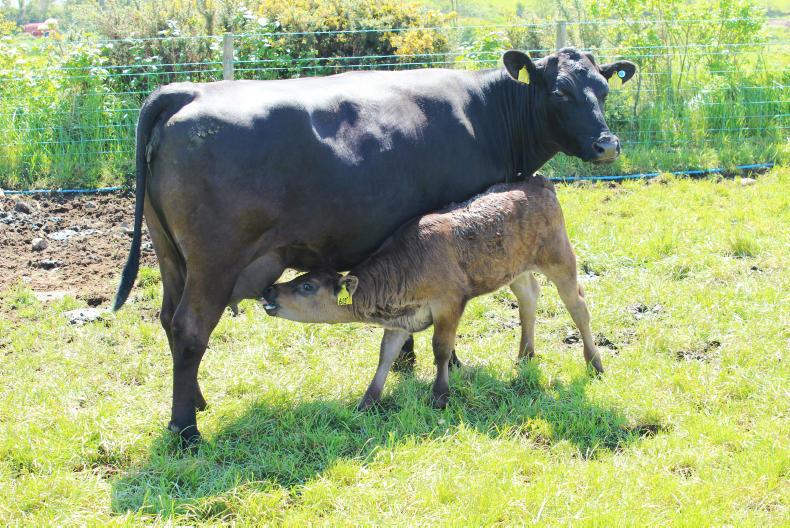We are now almost halfway through the calving period which started back on 22 March. As of last weekend, we had 37 (53%) cows calved from a total of 70 breeding females, all of which have a live calf at foot.
Based on scanning data, the remaining cows should finish calving by the first week of May. After a difficult start to March, weather conditions have turned in our favour.
We have taken advantage of the improved ground conditions to get cows and yearling stores out to grass. This has really cut down the workload. Prior to turnout, we were under real pressure for slurry storage.
Herd sires
Cows are predominantly calving to Angus stock bulls, with replacement heifers calving to a Salers bull.
In the last few years, we have experimented with AI on cows with reasonable success. Last summer, we bred a group of cows to AI using Charolais and Limousin sires.
From scanning data, we should have 16 cows in-calf to the Charolais bull, Fiston. So far, we have calved 11 of these cows, and, thankfully, they all have a live calf on the ground.
One cow calved to Lodge Hamlet, and two calved to Castleview Gazelle, both Limousin sires.
While AI has worked well, I work off farm during the week. This makes it less practical for heat detection and handling cows for insemination, so I am considering whether to purchase a new stock bull or to synchronise and AI cows again as it worked well in 2019.

Calving progress
Our mature cows are smaller than your typical suckler cow, so I was paying close attention to those in-calf to Fiston.
The first cow did need a small hand to deliver the calf, which was slower to get up and suck.
However, the rest have calved without any need for assistance and all calves were quick to stand and feed. So far, I am delighted with calf quality.
The cows calving to our Angus stock bulls are calving on their own and again, calves are quick to get up and suck.
Cow management
In the runup to calving, cows are on ad-lib silage and pre-calving minerals. Cows are calving down in good condition, with a few animals carrying slightly more flesh than I would like.
However, with our housing setup, cows lie in cubicles, so they have more space compared to cows penned on slats. This helps to keep cows that bit fitter indoors.
Grazing
All 37 cows that have calved are outside at grass. Over the past week, cows have been slipped outside to sheltered paddocks beside the main farmyard within 12 to 24 hours of calving.
Cows are kept in batches of six animals in each paddock for three to four days. At this point, the cow and calf unit has bonded properly and we move them to an outfarm, where they run in bigger groups.
Milk fever
Up until last week, turning cows out to grass was working well. However, late last week, we had three freshly calved cows taking milk fever.
The vet was able to treat this and the three cows are fine. We were using lick buckets to provide trace elements and cows were getting minerals pre-calving.
On reflection, I would imagine that milk fever was triggered by a combination of factors such as the stress of calving and the change in diet and environment after turnout. All freshly calved cows have since been given a high-calcium mineral bolus and there have been no further issues with milk fever.
Our 2019-born heifers went to grass on 17 March and are grazing in three groups. At the minute, these heifers have not received any vaccines for breeding.
Last year, we more or less put all of yearling heifers to the bull as we have developed a good market for selling in-calf replacements.
Chance are, we will do something similar this year. But first, we need to sort through the heifers and make sure they hit target breeding weight by the summer.
Heifers were fed good-quality silage over winter. Concentrates were eased back as some animals were starting to get too fleshy.
The last weighing for this group was on 18 February when the group averaged 335kg (276kg to 392kg). The strongest animals will be pulled out for breeding in June.
Bullocks
The 2019 bullocks went to grass on 30 March. There are 32 bullocks and they were weighed at turnout.
The group averaged 399kg and are running in two groups of 16 at grass. Unlike the heifers, we kept feeding these animals concentrate right up until turnout.
We are well pleased with how the bullocks performed over the winter housing period. Hopefully these animals will stay at grass until autumn, at which point we will start drafting them for slaughter.
The whole farm has received three-quarters of a bag of urea per acre in March.
As time is limited, we got a local contractor to spread fertiliser.
Nitrogen was applied using GPS which meant precision application. The whole farm was covered in four hours.
Silage
We also got a contractor in to spread slurry using an umbilical system and dribble bar.
All of the silage ground has now received slurry, with 37 acres closed off for harvesting in mid-May.
Silage ground has been topped up with 25-5-5 at 2.5 bags per acre. We still have close to 90 bales of silage, as well as an opened pit of fodder, so we should be fine for fodder next winter.
